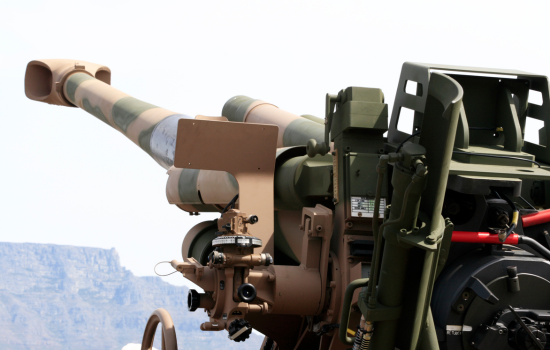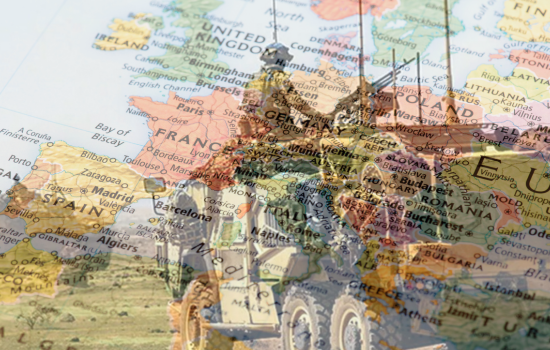Terror at Sea – The Maritime Threat
In the aftermath of the devastating attacks of 11 September 2001, governments around the world began scrambling to assess their vulnerability to highly-organized terrorist groups, which, like Al-Qaida and its ilk, are undaunted by the sacrifice of thousands of lives in realizing their objectives. Mega-terrorism, previously seen as a fictional threat, suddenly became very real. Security agencies around the world now view maritime transport as a prime target for future attacks.
Despite the elapse of time and the measures taken since 9/11, the maritime sector remains extremely vulnerable to terrorism, and it is expected that an attempted attack on a significant maritime target will take place during 2005.[1] Such concerns were heightened by the confirmation by Osama bin Laden himself in his October 2004 video that his agenda remains largely economic.
World trade is dependent mainly on maritime transport. The United Nations Conference on Trade and Development (UNCTAD) estimates that 5.8 billion tons of goods were traded by sea in 2001, accounting for over 80% of global trade volume. Over 46,000 vessels, servicing nearly 4,000 ports throughout the world, carry the bulk of this trade. Great strides have been made in recent years to render this system as open and frictionless as possible, so as to prompt yet greater economic growth. According to UNCTAD reports, world sea-borne trade peaked at 5.89 billion tons in 2002, exceeding the previous record set in 2000. These trade figures reflect the improved growth in world maritime trade and are expected to continue to grow.
However, the very factors that allow maritime transport to contribute to economic prosperity also leave it uniquely vulnerable to terrorism. The risks are numerous, and encompass passenger cruise ships and ferries, container and bulk shipping, not to mention the port facilities themselves. The vulnerabilities are significant and range from potential physical attacks on ports, vessels and shipments to document fraud and illicit fundraising for terrorist groups, illicit trafficking in and/or use of weapons, explosives, non-conventional or hazardous materials, and much more. The stakes are extremely high, since any major breakdown in the maritime transport system could cost dearly in terms of lives and would fundamentally cripple global trade.
The size, accessibility, and metropolitan location of many port facilities ensure a free flow of trade and travel, but these factors also make the monitoring and controlling of traffic through the ports very difficult.
Trends in maritime threats
While the threat of piracy is as old as maritime travel, the number of attacks by pirates reported around the world has more than tripled during the past 10 years. Areas of highest concern include Indonesia (Anambas Islands, Gelasa Straits), Bangladesh (Chittaging, Mongla), India (Chennai, Chochin, Haldia), Malaysia (Bintulu, Sandakan), Somalia and Nigeria.[3]
Al-Qaida is known to have a maritime military manual dealing with how to attack ships, and showing different classes of vessels, where to hit them and how much explosives are needed.[4] In addition, al-Qaida has a history of nautical attacks. The group’s tactics indicate an increase in strikes against shipping and port facilities as part of its push to hit economic targets. Intelligence officials have identified cargo freighters they believe are controlled by al-Qaida, which could be used by the terrorist network to ferry operatives, bombs, money, or commodities on the high seas.[5]
Over the years, terrorism has usually targeted land and/or aviation targets. However, many experts believe that this situation will change in the near future, inter alia, because of the very high vulnerability of maritime transportation, including shipping, port, coastal facilities and shipping containers, and maritime security has hitherto taken a back seat to the more urgent need to address aviation threats. Terrorists- particularly al-Qaida-threaten ships and ports directly. In 2000, a small boat filled with explosives rammed into the USS Cole in Yemen, and in October 2002 the French-owned supertanker Limburg was attacked in similar fashion in the Persian Gulf region. These incidents, coupled with updated intelligence, indicate that terrorists may be stepping up attacks against shipping, especially in the Middle East, and on Mediterranean sea ports and coalition force assets. Not only oil tankers and warships are under threat; future attacks could target commercial shipping, including cargo ships, cruise liners or even ferries, practically anywhere in the world.[6]
States participating in the coalition in Iraq seem to be at greater threat than other nations, at least in the short term. A recent case of particular interest is reported to have taken place in February 2004, when a 1,050-passenger ferry sank in the Philippines after a bomb, consisting of eight pounds of TNT packed into a television, was detonated in the lower decks.
Notwithstanding the investment in maritime security made by governments worldwide, the threat is still imminent. Even in the United States, where perhaps the greatest maritime budget has been allocated, the ports are far from secure. The port-security program “has not yet achieved its intended results in the form of actual improvement in port security,” according to the Department of Homeland Security’s own inspector general. The result is that the department “had no assurance that the program is protecting the nation’s most critical and vulnerable port infrastructure and assets.” [7]
The recent appointment of Saud Hamid al-Utaibi as new al-Qaida commander in Saudi Arabia-largely thanks to his expertise in marine terror-has caused many security experts to raise the threat level to maritime security. Hamid al-Utaibi’s experience includes an active role in blowing up the USS Cole in October 2000 and in attacking the French Limburg tanker two years later-both rammed by exploding speedboats in Yemeni waters. Subsequent to the appointment, the United States warned a number of Mediterranean states that maritime attacks involving chemical agents might be imminent.
The feasible modes of operation are far-reaching. To mention a few, terrorists could hijack a vessel, or they could register a ship in a ‘flag of convenience’ nation, and use it for terrorist activities; or they could purchase and make use of a legitimate shipping company and its vessels to carry out acts of terrorism without coming under suspicion. These ships could be loaded with explosives and crashed into other vessels, port facilities, critical infrastructure, or population centers on the coast.
Alternatively, oil tankers or vessels carrying hazardous materials could be used as terrorist weapons. The types of vessels mentioned above, major ports, coastal oil depots, power stations, harbors or bridges could be ideal targets for such attacks. Maritime attacks may also involve the use of small underwater craft, such as small submarines or underwater motor-propelled sleds for divers.[8] Some terrorist groups are known to have experimented with such methods. Intelligence reports point out that radicals from the Jemaah Islamiah (JI), a group linked to the al-Qaida network, have been trained in sea-borne guerilla tactics, such as suicide diving and ramming, developed by the Liberation Tigers of Tamil Eelam (LTTE).[9]
Terrorists could also gain unauthorized access to ships and port facilities to place explosives. At least one al-Qaida operative is known to have been in the process of obtaining an international seaman’s license that would allow him into any port in the world without a visa.[10]
One of the most frightening terrorist threats to maritime security involves terrorists smuggling and/or activating explosives or WMD in general-and dirty bombs in particular-into a sovereign country using cargo containers. Such a scenario became less notional after alert Italian security personnel in Gionia Tauro revealed the ‘Container Bob’ incident in October 2001. In that incident, an Egyptian man with Canadian citizenship, nicknamed “Container Bob”, was discovered when Port police in the Italian city of Gioia Tauro heard an unusual noise coming from a cargo container. Upon opening it, they discovered a well-dressed man drilling ventilation holes. He was equipped with a bed, a toilet, water supply, satellite phone, laptop computer, cameras, and maps. He also had security passes to various airports in North America.
A weapon smuggled in such a container could be detonated upon arrival at the port or at any strategic point along the container’s route. Targets could include strategic transportation nodes, symbolic landmarks, or large population centers. In addition to death and destruction, any such attack using WMD would undoubtedly have a traumatic effect on the national psyche, not to mention the regional and global economy.
There are regions that are more susceptible than others to maritime attack. This vulnerability stems from both tangible and intangible variables, with one of the primary variables being geographic location. Countries considered of higher susceptibility are countries with maritime routes easily accessed from states that are believed to have terrorist organizations operating from their waters, such as Lebanon, Syria, Libya and others.
What should be done
To successfully confront terror, it has become widely acknowledged that candid and constant international cooperation is a must. This cooperation is even more vital when attempting to mitigate the maritime threat, due to its international idiosyncrasies.
Enhanced physical security of port facilities, increased patrols of waterways, ports and coastal facilities, container security and protection against explosives and the creation of databases to track cargo, ships and seaman are all imperative measures in mitigating the threat. Nevertheless, they will almost all be for naught, if international agreements and cooperation are not upheld.
The International Ship and Port Facility Security Code (the “Code”) is an important international security initiative developed by the International Maritime Organization, which has 148 state members
The Code contains security-related requirements for governments, port authorities and shipping companies, together with a series of guidelines on how to meet these necessities. The Code requirements were to have been implemented by July of 2004; however, many large and vulnerable ports have yet to comply with the international requirements. This lack of compliance leaves the entire maritime industry vulnerable to attack.
[1] Aegis 2005 Terrorism report
[2] https://www.unctad.org/en/docs//rmt2003_en.pdf
[3] UN 2003 piracy report
[4] ‘International shipping vehicles vulnerable to terrorist attacks, FBI warns’, Gregory Katz, Dallas Morning News, December 1, 2002
[5] ‘Fifteen Freighters Believed to Be Linked To Al Qaeda’, Op. Cit.
[6] ‘International shipping vehicles vulnerable to terrorist attacks, FBI warns’, Op. Cit.
[7] New York Times 27.2.05
[8] ‘Possible Use of Scuba Divers to Conduct Terrorist Attacks – Information Bulletin 02-006’, National Infrastructure Protection Center, May 23, 2002, https://www.nipc.gov/publications/infobulletins/2002/ib02-006.htm
[9] ‘Experts says Islamic Militants Trained for Sea Attacks’, Reuters, January 22, 2003
[10] ‘Qaeda Suspect Was Taking Flight Training Last Month’, Patrick E. Tyler, New York Times, December 22, 2002






